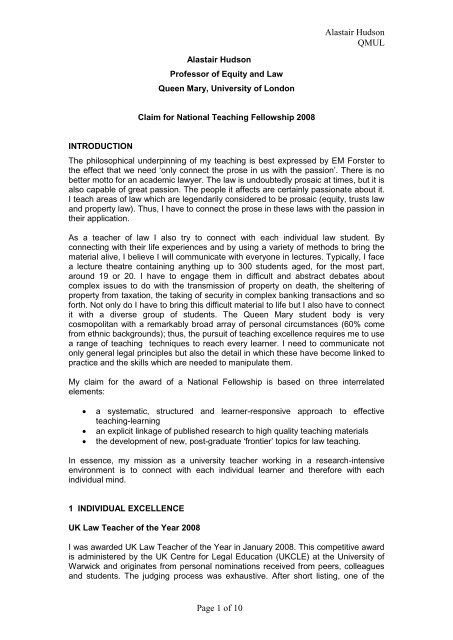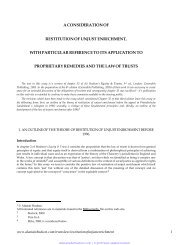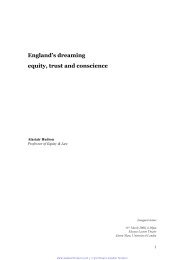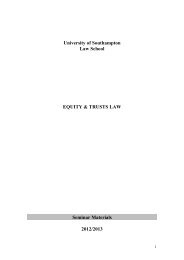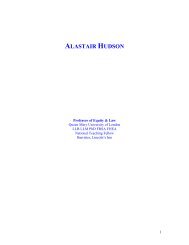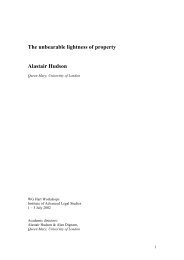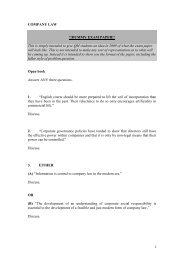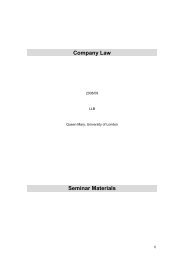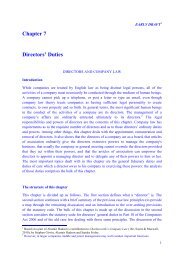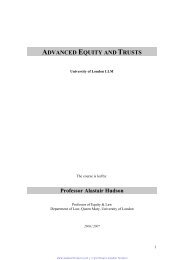The underpinning of my philosophy of teaching was best expressed ...
The underpinning of my philosophy of teaching was best expressed ...
The underpinning of my philosophy of teaching was best expressed ...
You also want an ePaper? Increase the reach of your titles
YUMPU automatically turns print PDFs into web optimized ePapers that Google loves.
Alastair HudsonQMULto do some extra work at home and practise some exam questions he wouldhappily take them on and give us feedback.A. ……..it <strong>was</strong> very clear what you had to do if you wanted to do wel..C. ‘He knows everything about Trusts. Absolutely everything!He missed nothing. It just didn’t happen. You got the feeling that you couldrely on what he said.’Three elements in particular emerge from these evaluations First, experientialdescriptions <strong>of</strong> a lecturing style which demonstrates <strong>my</strong> determination to structure thematerial clearly and to present it with enthusiasm and commitment. Secondly, anappreciation <strong>of</strong> the various on-line resources which I make available to students.Thirdly, positive responses to <strong>my</strong> pastoral care and genuine commitment to creatinga high quality learning community based on ‘cognitive apprenticeship’. (Bandura, A1997, Social Learning <strong>The</strong>ory). All these issues are considered in greater detailbelow.Other student testimonials<strong>The</strong>re is, to <strong>my</strong> never-ending embarrassment, an area on ‘Facebook’ (I am reliablyinformed) called the ‘Hudson Adoration Society’ which contains 44 enthusiasticstudent comments 83 student have joined the group).. A colleague also found thefollowing statement on ‘<strong>The</strong> Student Room’ web-site:By the way, as an update, I revoke the ban on applauding for any lecturegiven by Alastair Hudson. That last lecture <strong>was</strong> fantastic, and he earned themid-lecture applause (followed by his bow) for his rant on love, Lexus cars,PE teachers and death.This ‘rant’ is an annual feature <strong>of</strong> <strong>my</strong> second year lectures when I feel students needreassurance that all their hard work will pay <strong>of</strong>f in the long run. <strong>The</strong> occasionaltransformation <strong>of</strong> <strong>my</strong> lectures into entertainment should never be overlooked, nor <strong>my</strong>determination to empathize with their experience and ambitions as students.<strong>The</strong> 2002/03 Undergraduate Yearbook (the only year in which one <strong>was</strong> produced)recorded 39 unsolicited, complimentary comments from students about me, out <strong>of</strong>120 students with a Yearbook entry. Comments included:a positive ray <strong>of</strong> sunshinefunny, intelligent and friendlyenthusiastic and humorous lectures….[he] goes beyond his duties as alecturer in looking out for the well being <strong>of</strong> his studentsmade the hardest subject easiest to understand …. I’ve greatly enjoyed hislecturesthat rara avis, a top-class academic and visionary with a keen sense <strong>of</strong>humour.Page 3 <strong>of</strong> 10
Alastair HudsonQMULnearly 40% in the May exams. This had been a course feature for some time since aformer lecturer had attempted to impose a conceptual organisation for the coursewhich <strong>was</strong> supported by no textbook and which, by way <strong>of</strong> example, required everystudent to access a single copy <strong>of</strong> a textbook held on weekly loan in the library forone particular tutorial.I restructured the course so that early tutorials followed on explicitly from the casereadingskills element <strong>of</strong> the foundation course. This gave students greater continuityfrom their foundational studies. It also increased their confidence by putting their coreskills to work. <strong>The</strong> course <strong>was</strong> further reorganised around one <strong>of</strong> two recommendedtextbooks and easily accessible cases. <strong>The</strong> initial course topic in the rearrangedprogramme – on the distinction between leases and licences – <strong>was</strong> deliberatelychosen because it: <strong>was</strong> rich in case law (so that each student could prepare a casethemselves to present in tutorials); <strong>was</strong> the easiest three-part rule on the course (andso easy for an first-year student lacking in confidence to assimilate) and it began thelearning process with a general topic (i.e. the law <strong>of</strong> leases) the subject matter <strong>of</strong>which is much more accessible than, for example, the abstractions <strong>of</strong> landregistration. When aggregated these improvements increased student progressionrates to nearly 80% in subsequent exams without jettisoning any <strong>of</strong> the morechallenging material.My approach to curriculum structureMuch <strong>of</strong> the success <strong>of</strong> a law course lies in its structure, just as the success <strong>of</strong> astory lies in the order and the manner in which it is told. In structuring law courses, Ibegin with fundamental theoretical concepts which are illustrated by comparativelyeasy technical ideas to generate student confidence and momentum. Progressionthrough the course is then dependent on acquiring a greater volume <strong>of</strong> technicallegalprinciples and theoretical perspectives, and moving through increasinglyconceptual and abstract ideas which build on earlier threshold concepts. Thisfacilitates student’s momentum through progressive levels <strong>of</strong> achievement.When writing for students and structuring university programmes <strong>of</strong> study I invariablybegin with foundational principles and add, layer-on-layer, more complex ideas whichlearners need to absorb in order to reach a level <strong>of</strong> attainment necessary for theintellectual integrity <strong>of</strong> the course. This approach to the acquisition <strong>of</strong> higher orderthinking skills has a sound, proven foundation in cognitive learning theory (Ausubel,D et al 1978 Educational Psychology: A Cognitive View). By contrast, when writingfor practitioners, one approaches these issues in a conceptual order that is lessconcerned with imbuing the reader with skills.I have developed systems <strong>of</strong> assessment, support and feedback including: ‘commonproblems with essays’ documents; suggested solutions; lecture support <strong>of</strong> seminars;visual, tick-box assessment forms organised by skills exhibited in the assessment;and so forth. I undertake a large amount <strong>of</strong> problem-answering and essay-writingwork in lectures to illustrate the skills which the students must develop. In part this ismotivated by questions <strong>of</strong> equity and a desire ‘to level the playing field’ betweenstudents who are taught in seminars by part-time teachers and those who are not.<strong>The</strong> same is true <strong>of</strong> <strong>my</strong> podcasts.<strong>The</strong> effectiveness <strong>of</strong> the approach is evidenced by the large number <strong>of</strong> students whoprogress from this mode <strong>of</strong> study into conducting research in these fields by way <strong>of</strong>an optional, dissertation course under <strong>my</strong> supervision.Page 5 <strong>of</strong> 10
Alastair HudsonQMULEnhancing the <strong>teaching</strong>- research nexusPublished research in law – whether in the form <strong>of</strong> student textbooks, practitionertreatises or journal articles – constitutes primary material if the research is cited incourt by judges, as <strong>my</strong> work has been, or if they genuinely conceptualise and orderthe existing case law and statutory principles. In this sense <strong>my</strong> published researchconstitutes a body <strong>of</strong> <strong>teaching</strong> materials. My student textbooks in particular havedeveloped novel ways <strong>of</strong> presenting material in <strong>my</strong> specialist fields, both in terms <strong>of</strong>accounts <strong>of</strong> technical concepts and also in terms <strong>of</strong> the <strong>teaching</strong> <strong>of</strong> self-reflectiveskills which I embed and undertake through these materials. On-line podcasts andessays then personalise skills <strong>teaching</strong> and advise on assessments withoutinterfering with pedagogic study.I take tremendous pr<strong>of</strong>essional pleasure in <strong>my</strong> research, whether it has been writtento teach law to students or to provide an analysis <strong>of</strong> for practitioners. Frequently,especially in the field <strong>of</strong> finance law, <strong>my</strong> research acts as a primary resource forscholars and practitioners in frontier areas where little has been written or decided bythe courts.<strong>The</strong> <strong>best</strong> example <strong>of</strong> this marriage <strong>of</strong> <strong>teaching</strong> and research is <strong>my</strong> textbook Equity &Trusts (5 th edition, Routledge-Cavendish, 2007). <strong>The</strong>re are a number <strong>of</strong> distinctivefeatures which I believe make this book more ‘student-friendly’ than others:the book is written with a controlled enthusiasm I do not discern in many otherlegal textbooks;it is written primarily to teach students rather than to impress otheracademics;each section begins with a summary <strong>of</strong> relevant principles before going on toanalyse these in depth. This means students know what principle they areseeking to study before they begin their reading. This acts as an ‘advancedorganiser’ which is essential to the successful study <strong>of</strong> law and encouragesdeep learning;each chapter has easy-to-understand, worked examples <strong>of</strong> legal principles,before then turning to the detail <strong>of</strong> the decided cases and statute. Again, byworking through hierarchical levels, students more easily develop coreunderstandings before seeing these worked through;the book advances a thesis <strong>of</strong> the nature <strong>of</strong> equity over its 1,200 pages (thusengaging with key pedagogic debates) as well as discussing the technicalmaterial which all trusts law courses require. This makes the book a bettercompanion over the course <strong>of</strong> a programme <strong>of</strong> study because it is constantlygiving a perspective on the technical material and so lifts the student out <strong>of</strong>the drudgery <strong>of</strong> note-taking;the book is interspersed with essays providing summations <strong>of</strong> severalchapters which tend to be studied separately by the typical student reader.Each essay is supported by free-to-air podcasts. <strong>The</strong> overall intention is toteach detailed concepts within an accessible theoretical framework. No otherbook in the field takes this approach.One review <strong>of</strong> the 3 rd edition <strong>of</strong> Equity & Trusts considered that:‘Any textbook on English law that quotes Aristotle and discusses chaostheory is likely to contain an interesting approach. Equity & Trusts does notdisappoint. … [it] takes a radically different approach from other books …Page 6 <strong>of</strong> 10
Alastair HudsonQMULI have taught international audiences <strong>of</strong> legal and financial practitioners in Geneva,Malta, Dublin, Catania and frequently in London. Each <strong>of</strong> these ventures has led torepeated invitations to speak, always as sole presenter, and frequently to run one- ortwo-day seminars. My CV records work as an external examiner in eight otheruniversities, including the Institute <strong>of</strong> Advanced Legal Studies, London and HongKong University. I consider service <strong>of</strong> this kind essential for benchmarking <strong>my</strong> own<strong>teaching</strong> practice and for ensuring our departmental procedures are rigorous and fitfor purpose.3 DEVELOPING EXCELLENCEResearching, publication and the production <strong>of</strong> student-focused <strong>teaching</strong> texts aremajor vehicles for reviewing and enhancing <strong>my</strong> own performance. Together, theyform a powerful means <strong>of</strong> securing continued pr<strong>of</strong>essional development andachieving improvement in the quality <strong>of</strong> <strong>my</strong> students’ learning experiences. Othermechanisms include:Developing <strong>my</strong> own web-siteI have built, written and maintained <strong>my</strong> own web-site for a number <strong>of</strong> years previousto this (www.alastairhudson.com). <strong>The</strong> intention <strong>was</strong> tw<strong>of</strong>old: first, to supplement <strong>my</strong><strong>teaching</strong> and, secondly, to provide an outlet for <strong>my</strong> writing more generally. I createdthe web-site initially so that I could both keep <strong>my</strong> courses up-to-date with case notesand essays, and also to provide students with gateways into further study and selfdirectedresearch. In <strong>my</strong> LLM course Advanced Equity & Trusts, I <strong>was</strong> able to keep alog <strong>of</strong> class discussions on-line so that we could trace and evaluate the directions inwhich we had taken the material: this facilitated an experimental, open-texturedapproach to the subject without students feeling we might lose our moorings.As a means to reach out to that small part <strong>of</strong> the lecture hall which <strong>was</strong> still notconnecting with <strong>teaching</strong> provided solely through classes and textbooks, in 2005 Ibought an MP3 recorder, some web development s<strong>of</strong>tware and some sound mixings<strong>of</strong>tware <strong>my</strong>self so that I could record podcasts.My web-site now contains over 50 podcasts, most <strong>of</strong> which were recordedspecifically to support <strong>my</strong> textbook, Equity & Trusts. I produce podcasts for studentsat two levels: the first provides introductory materials for students about to begin theirstudies and the second provides pathways into further research. Each podcast canbe downloaded and played on any MP3 player or through a computer. <strong>The</strong> soundhas been mixed so that podcasts take up minimal memory space and yet arerecorded at a suitable volume level.Beyond the ordinary support materials for <strong>my</strong> taught courses, the web-site alsocontains hundreds <strong>of</strong> pages <strong>of</strong> social theory, fiction and other material which bothinforms and runs parallel to <strong>my</strong> <strong>teaching</strong>. As I am also responsible for the QMULWebCT areas relating to <strong>my</strong> taught courses I can ensure provision from either sourceis complementary.Participation in ongoing review <strong>of</strong> <strong>teaching</strong>I have served as Senior Tutor and Deputy Head <strong>of</strong> the Law Department (a positiondefined at the time as bearing ‘responsibility for the delivery <strong>of</strong> the LLB programme’).At the same time I directed the Foundation Course, and taught land law, equity andPage 9 <strong>of</strong> 10
Alastair HudsonQMULtrusts, and company law. As course leader I am responsible for the review <strong>of</strong> parttimeteachers and their CPD through mentoring.At this time I also chaired the Undergraduate Affairs Committee and the Staff-StudentLiaison Committee, as well as being responsible for the Department’s response toQAA Teaching Quality Assessment. I <strong>was</strong> responsible for the Internal Review <strong>of</strong> Lawin 2001 and for Law’s participation in the 2004 QAA Institutional Audit. Currently Iserve on the Law School Teaching and Learning Committee in <strong>my</strong> role as AcademicTutor. It is in this role that I participate most obviously with colleagues in consideringacademic policy relating to the delivery <strong>of</strong> <strong>teaching</strong> and the relationship betweenacademic staff and students. I also serve on the Law and Social Sciences FacultyBoard, which is responsible for <strong>teaching</strong> quality matters.MentoringI undertake a lot <strong>of</strong> mentoring on an informal ad hoc basis. One, long-standingexample may illustrate this: I mentored R.H. during her undergraduate studies atQueen Mary and then continued in that role informally when she studied for an LLMat King’s College, before she returned here to begin a PhD under <strong>my</strong> supervision. Onbeginning her doctoral studies she also began <strong>teaching</strong> land law as part <strong>of</strong> <strong>my</strong> QMULteam. I have thus known R. through all stages <strong>of</strong> her university career.<strong>The</strong> mentoring I provide entails frequent discussion <strong>of</strong> <strong>teaching</strong> strategy, especiallythe enhancement <strong>of</strong> optimal learning and formative assessment methods for ourcourses. We speak at least once a week about our <strong>teaching</strong> and this serves as anear-constant process <strong>of</strong> monitoring individual student performance on the differentcourses we teach. Importantly, it also helps scrutiny <strong>of</strong> our own in-class performance.We are contracted to write a textbook together for Routledge-Cavendish called <strong>The</strong>Law <strong>of</strong> Property, which will open a new chapter in our pr<strong>of</strong>essional development andco-operation.R. is by no means the only ‘student-into-colleague’ I have helped and encouraged. Asimilar mentoring process has supported five other former students through theirtransition to university teachers and colleagues.ConclusionWorking at Queen Mary has provided me with a fertile and challenging environmentin which to develop <strong>my</strong> practice, reflect on what I do and contribute to theenhancement <strong>of</strong> student learning. I hope this application reflects both <strong>my</strong>commitment to an effective pedagogy for law and <strong>my</strong> enthusiasm to deploy researchledactivities for the pr<strong>of</strong>essional formation <strong>of</strong> intending and practising lawyers. Bothare clearly linked. When engaged with either <strong>my</strong> approach can be summarised as: Icommunicate. I connect. I care.* 4894 wordsPage 10 <strong>of</strong> 10


